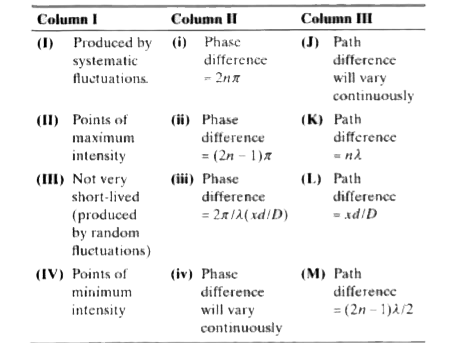In the given table, column I shows the different types of decays in nuclear fission, collumn II show the change in the element which undergoes decay and Column III shows properties of different types of decays.

What are the characteristics of the below nuclear equation?
AzX (mother nucleus) AZ+1Y (daughter nucleus)+0−1e
(III)(ii)(J)
(II)(iii)(M)
(II)(iii)(M)
(I)(i)(M)
The correct Answer is:A, B, C, D
Topper's Solved these Questions
- THE NUCLEUSBOOK - RESNICK AND HALLIDAYCHAPTER - THE NUCLEUSEXERCISE - PRACTICE QUESTIONS(Integer Type)
7 Videos
- THE NUCLEUSBOOK - RESNICK AND HALLIDAYCHAPTER - THE NUCLEUSEXERCISE - PRACTICE QUESTIONS (Linked Comprehension)
12 Videos
- THE KINETIC THEORY OF GASESBOOK - RESNICK AND HALLIDAYCHAPTER - THE KINETIC THEORY OF GASESEXERCISE - PRACTICE QUESTIONS
72 Videos
- UNITS AND MEASUREMENT BOOK - RESNICK AND HALLIDAYCHAPTER - UNITS AND MEASUREMENT EXERCISE - PRACTICE QUESTIONS (MATRIX-MATCH)
11 Videos
Similar Questions
In the given table Column I shows the different values of masses of the body. Column II shows the different values of angular speed of the body and Column III shows the radius of circle in which the body moves.

Which combination has 0.13N as the centrepetal force?
View SolutionIn the given table Column I shows the different values of masses of the body. Column II shows the different values of angular speed of the body and Column III shows the radius of circle in which the body moves.

Which combination has 0.199N as the centrepetal force?
View Solution
Knowledge Check
In the given table, column I shows the different types of decays in nuclear fission, collumn II show the change in the element which undergoes decay and Column III shows properties of different types of decays.

What are the characteristics of the below nuclear equation?
AZX⋅ (mother nucleus)→AZY (daughter nucleus ) +hfA(III) (iv)(L)B(I)(i)(K)C(III)(iii)(J)D(I)(ii)(M)In the given table, column I shows the different types of decays in nuclear fission, collumn II show the change in the element which undergoes decay and Column III shows properties of different types of decays.

What are the characteristics of the below nuclear equation?
AZX(mother nucleus) →A−4Z−2Y(daughter nucleus) +42HeA(I)(ii)(J)B(IV)(ii)(M)C(II)(iv)(K)D(I)(ii)(J)Many side particles are produced when radioactive decay takes place.In the given table, Column I shows the charge of the different side particles, Column II shows the mass and Column III shows the ionization power of these side particles.

What are the characteristics of α- particle?A(I)(ii)(J)B(IV)(i)(M)C(II)(iv)(K)D(I)(i)(K)
In the given table, Columns I and II given statements regarding different types of motion of particle along straight line and Column III shows figures depicting the motion.

(1) Which combination of statements is characteristic of oscillatory motion ?
View SolutionInterference is an important property of light. In the given table, Column I shows the properties of interfering waves, Column II shows the phase difference, and Column III shows the path difference between two interfering waves

What are the conditions for sustained interference?
View SolutionInterference is an important property of light. In the given table, Column I shows the properties of interfering waves, Column II shows the phase difference, and Column III shows the path difference between two interfering waves

What are the conditions for destructive interference?
View SolutionMany side particles are produced when radioactive decay takes place.In the given table, Column I shows the charge of the different side particles, Column II shows the mass and Column III shows the ionization power of these side particles.

What the characteristics of gamma - particles?
View SolutionMany side particles are produced when radioactive decay takes place.In the given table, Column I shows the charge of the different side particles, Column II shows the mass and Column III shows the ionization power of these side particles.

What the characteristics of β- particle?
View Solution
